List of large Hindu temples
This is a list of Hindu Temples in terms of area. [1]
| Rank | Name of the temple | Photo | Area (m²) | Location | Architecture/Timeline |
|---|---|---|---|---|---|
| 1 | Angkor Wat |  |
820,000 | Angkor, Cambodia | Angkor Wat is a temple complex at Angkor, Cambodia, built for the king Suryavarman II in the early 12th century as his state temple and capital city. As the best-preserved temple at the site, it is the only one to have remained a significant religious center since its foundation — first Hindu, dedicated to the god Vishnu, then Buddhist.[2] |
| 2 | Sri Ranganathaswamy Temple, Srirangam | 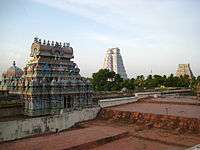 |
631,000 | Tiruchirappalli, Tamil Nadu, India | Srirangam temple is often listed as the largest functioning Hindu temple in the world (the still larger Angkor Wat being the largest existing temple). The temple occupies an area of 156 acres (631,000 m²) with a perimeter of 4,116m (10,710 feet) making it the largest temple in India[3] and one of the largest religious complexes in the world. The temple is enclosed by seven concentric walls (termed prakarams (outer courtyard) or mathil suvar) with a total length of 32,592 feet or over six miles. These walls are enclosed by 21 Gopurams. The Ranganathanswamy Temple complex with 49 shrines, all dedicated to Lord Vishnu, is so huge that it is like a city within itself. However, the entire temple is not used for the religious purpose, the first three out of seven concentric walls are used by private commercial establishments such as restaurants, hotels, flower market, and residential homes.[4] Taking this detail into account, still the temple ranks third to in the list of large Hindu temples after Thillai Nataraja Temple, Chidambaram and Tiruvannamalai Annamalaiyar Temple. |
| 3 | Akshardham | .jpg) |
240,000 | Delhi, India | Akshardham is a Hindu temple complex in Delhi, India.[5] Also referred to as Delhi Akshardham or Swaminarayan Akshardham, the complex displays millennia of traditional Indian and Hindu culture, spirituality, and architecture. The building was inspired and moderated by Pramukh Swami Maharaj, the spiritual head of the Bochasanwasi Shri Akshar Purushottam Swaminarayan Sanstha, whose 3,000 volunteers helped 7,000 artisans construct Akshardham.[5][6] |
| 4 | Belur Math, Ramakrishna temple | |
160,000 | Howrah, West Bengal, India | Belūr Maṭh or Belur Mutt is the headquarters of the Ramakrishna Math and Mission, founded by Swami Vivekananda, a chief disciple of Ramakrishna Paramahamsa. It is located on the west bank of Hooghly River, Belur, West Bengal, India and is one of the significant institutions in Calcutta. This temple is the heart of the Ramakrishna Movement. The temple is notable for its architecture that fuses Hindu, Christian and Islamic motifs as a symbol of unity of all religions.[7] |
| 5 | Thillai Nataraja Temple, Chidambaram |  |
160,000 | Chidambaram, Tamil Nadu, India | Thillai Natarajah Temple, Chidambaram - Chidambaram Thillai Natarajar-Koothan Kovil or Chidambaram temple is a Hindu temple dedicated to Lord Shiva located in the centre of the temple town of Chidambaram, east-central Tamil Nadu, South India. Chidambaram is a temple complex spread over 40 acres (160,000 m2) in the heart of the city. It is truly a large temple which is completely used for religious purpose. The main complex to Lord Shiva Nataraja also contains shrines to deities such as Sivakami Amman, Ganesh, Murugan and Vishnu in the form Govindaraja Perumal. |
| 6 | Prambanan, Trimurti temple compound | 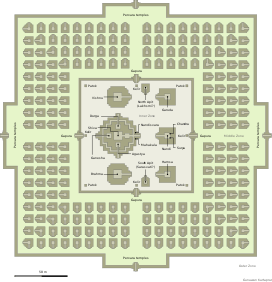 |
152,000 | Yogyakarta, Indonesia | Candi Prambanan or Candi Rara Jonggrang is a 9th-century Hindu temple compound in Central Java, Indonesia, dedicated to Shiva. It also houses shrines of Vishnu, Brahma and their consorts. The temple compound is located approximately 17 kilometres (11 mi) northeast of the city of Yogyakarta on the boundary between Central Java and Yogyakarta provinces.[8]
The temple compound, a UNESCO World Heritage Site, is the largest Hindu temple site in Indonesia, and one of the biggest in Southeast Asia. It is characterized by its tall and pointed architecture, typical of Hindu temple architecture, and by the towering 47-metre-high (154 ft) central building (Shiva shrine) inside a large complex of individual temples.[9] Prambanan attracts many visitors from across the world.[10] |
| 7 | Brihadeeswarar Temple | 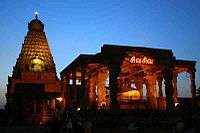 |
102,400 | Thanjavur, Tamil Nadu, India | Brihadeeswarar Temple also called The Big Temple was built by Raja Raja Chola I in 1010 CE and is dedicated to Shiva. The Big Temple is not only a magnificent edifice with its majestic vimana, sculptures, architecture and frescoes, but also has a wealth and richness of Tamil inscriptions engraved on stone in superb calligraphy. The temple is part of the UNESCO World Heritage Site. One wonders of how such a big temple could be built in flat 6 years taking into account the amount stone and soil to be moved and the lack of powered machinery available in those days. The massive sized main Vimanam (Tower) is 200 feet high, possibly the highest in the world when it was built. The Vimanam has 16 elaborately articulated stories, and dominates the main quadrangle.It has a monolithic Nandhi weighing about 25 tonnes, and is about 12 feet high and 20 feet long.The presiding deity of lingam is 12 feet tall.[11] |
| 8 | Annamalaiyar Temple |  |
101,171 | Tiruvannamalai, Tamil Nadu, India | Annamalaiyar Temple is a noted Hindu temple dedicated to Lord Shiva, and it is the second largest temple (by the area used completely for religious purpose). It has got four stately towers on all the four sides and four high stone walls just like the rampart walls of a fort. The 11-tiered highest (217 feet (66 m)) Eastern Tower is called the Rajagopuram. The fortified walls pierced with four gopura entrances offer a formidable look to this vast complex.[12] |
| 9 | Rajagopalaswamy temple |  |
93,000 | Mannargudi, Tamil Nadu, India | Rajagopalaswamy temple is a Vaishnavite shrine located in the town of Mannargudi, Tamil Nadu, India.[1]The Front Temple tower is 156 feet tall. The presiding deity is Rajagopalaswamy, a form of Lord Krishna. The temple is spread over an area of 23 acres (93,000 m2) and The temple tank is called Haridra Nadhi, 1,158 feet long and 837 feet broad 23 acers (93,000 m2) is one of the important Vaishnavite shrines in India. The temple is called Dakshina Dwarka (Southern Dwarka) along with Guruvayoor by Hindus.[2]. The temple is also 23 acers and the Temple tank Haridra Nadhi is also 23 acers making it one of the largest temple tanks in India[2][4] |
| 10 | Ekambareswarar Temple |  |
92,860 | Kanchipuram, Tamil Nadu, India | Ekambareswarar Temple is a Hindu temple dedicated to Lord Shiva, located in Kanchipuram in the state of Tamil Nadu, India. It is one of the five major Shiva temples or Pancha Bootha Sthalams (each representing a natural element) representing the element Earth. |
| 11 | Varadharaja Perumal Temple | |
81,000 | Kanchipuram, Tamil Nadu, India | Varadharaja Perumal Temple is dedicated to Lord Vishnu located in the holy city of Kanchipuram, Tamil Nadu, India. It is one of the Divya Desams, the 108 temples of Vishnu believed to have been visited by the 12 poet saints, or Alwars.[13] It is located in a suburb of Kanchipuram known as the Vishnu Kanchi that is a home for many famous Vishnu temples. One of the greatest Hindu scholars of Vaishnava VisishtAdvaita philosophy, Ramanuja is believed to have resided in this temple. |
| 12 | Tiruvarur Thyagarajaswamy Temple |  |
80,937 | Tiruvarur, Tamil Nadu, India | The ancient Sri Thyagaraja temple at Tiruvarur is dedicated to the Somaskanda aspect of Shiva. The temple complex has shrines dedicated to Vanmikanathar, Tyagarajar and the Kamalaamba, and covers an area of over 20 acres (81,000 m2) The Kamalalayam temple tank covers around 16 acres (65,000 m2),[14] one of the largest in the country. The temple chariot is the largest of its kind in Tamil Nadu.[15] |
| 13 | Jambukeswarar Temple, Thiruvanaikaval | 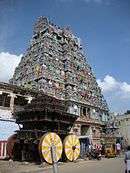 |
72,843 | Trichy, Tamil Nadu, India | Thiruvanaikaval (also Thiruvanaikal) is a Shiva temple in Tiruchirapalli (Trichy), in the state of Tamil Nadu, India. The temple was built by Kocengannan (Kochenga Chola), one of the Early Cholas, around 1,800 years ago.[16] |
| 14 | Nellaiappar Temple | 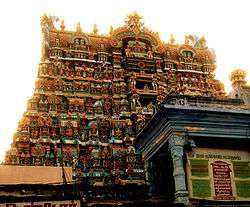 |
71,000 | Tirunelveli, Tamil Nadu, India | This temple, dedicated to Shiva, was built 2500–3000 years ago. The river Tamirabharani referred to by poets as "Porunai" flows round the city. One of the famous temples in India steeped in tradition and history and also known for its musical pillars and other brilliant sculptural splendor. The temples were built by Muluthukanda Rama Pandiyan. The musical pillars in the Mani Mandapam which produce sound in various pitches when struck, the Somavara Mandapam, the 1000 pillared hall, and the Tamra sabha with intricate wood work, and the Vasantha Mandapam are some of the noteworthy points in this temple. The temple car belongs to this temple is the third largest temple car in India and it is more than 510 years ago and it is the oldest car festival in the world. |
| 15 | Meenakshi Amman Temple | 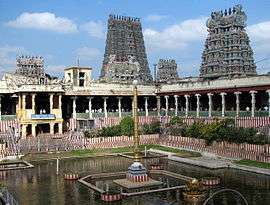 |
70,050 | Madurai, Tamil Nadu, India | Meenakshi Sundareswarar Temple or Meenakshi Amman Temple is dedicated to Lord Shiva — who is known here as Sundareswarar or Beautiful Lord — and his consort, Parvati who is known as Meenakshi. The temple forms the heart and lifeline of the 2500-year-old city of Madurai. The complex houses 14 magnificent Gopurams or towers including two golden Gopurams for the main deities, that are elaborately sculptured and painted showing the architectural and sculpting skills of the ancient Indian sthapathis. |
| 16 | Vaitheeswaran Koil |  |
60,780 | Vaitheeswaran Koil, Tamil Nadu, India | Vaitheeswaran Temple is located in Tamil Nadu, India, dedicated to the god Shiva. In this temple, Lord Shiva is worshiped as "Vaitheeswaran" or the "God of medicine"; worshipers believe that prayers to Lord Vaitheeswaran can cure diseases. |
| 17 | Jagannath Temple, Puri |  |
37,000 | Puri, Odisha, India | The Jagannath Temple in Puri is a famous Hindu temple dedicated to Jagannath (Vishnu) in the coastal town of Puri in the state of Odisha, India. The name Jagannath (Lord of the Universe) is a combination of the Sanskrit words Jagat (Universe) and Nath (Lord of).[17] |
| 18 | Birla Mandir |  |
30,000 | Delhi, India | The Laxminarayan Temple (also known as the Birla Mandir) is a Hindu temple dedicated to Laxminarayan in Delhi, India. The temple is built in honour of Lakshmi (Hindu goddess of wealth) and her consort Narayana (Vishnu, Preserver in the Trimurti). The temple was built in 1622 by Vir Singh Deo and renovated by Prithvi Singh in 1793. During 1933-39, Laxmi Narayan Temple was built by Baldeo Das Birla of Birla family. Thus, the temple is also known as Birla Mandir. The famous temple is accredited to have been inaugurated by Mahatma Gandhi in 1939. At that time, Gandhi kept a condition that the temple would not be restricted to the Hindus and people from every caste would be allowed inside. Since then, funds for further renovations and support have come from the Birla family.[18] |
See also
- List of large temple tanks
- Lists of Hindu temples by country
- List of human stampedes in Hindu temples
References
- ↑ "Tamil Nadu, Andhra Pradesh build temple ties to boost tourism". The Times of India. 2010-08-10. Retrieved 2011-09-21.
- ↑ "Angkor Temple Guide". Angkor Temple Guide. 2008. Retrieved 31 October 2010.
- ↑ "Tiruvarangam Divya Desam".
- ↑ Malcolm, p. 69
- 1 2 "What is Akshardham". BAPS Swaminarayan Sanstha. Retrieved 2008-10-28.
- ↑ "Mandir". BAPS. 2005. Retrieved 2008-09-12.
- ↑ Sarina Singh; Joe Bindloss; Paul Clammer; Janine Eberle. India. p. 452.
- ↑ Prambanan Temple Compounds – UNESCO World Heritage Centre
- ↑ http://www.borobudurpark.co.id/prambanan-temple-complex.html
- ↑ Prambanan Temple
- ↑ "Brihadeeswarar Temple". 2015. Retrieved 9 May 2015.
- ↑ "Complete Info about Tiruvannamalai Temple". 2010. Retrieved 30 August 2011.
- ↑ Hindu Pilgrimage: A Journey Through the Holy Places of Hindus All Over India. Sunita Pant Bansal. page 82
- ↑ "Tiruvarur Temple Layout". Retrieved 2006-11-11.
- ↑ "Thiruvarur at Tamil Nadu tourism website". Retrieved 2006-11-11.
- ↑ "Tiruvanaikoil Temple". 2010. Retrieved 30 August 2011.
- ↑ "Vedic Concepts". Retrieved 2006-09-12.
An example in Sanskrit is seen with the word Jagat which means universe.
- ↑ Birla Temple Delhi
- Malcolm, Howard, Travels in south-eastern Asia, embracing Hindustan, Malaya, Siam .., Volume 2, Google(digitised).
Shri Dirgh Vishnu Mandir, Gheea Mandi, Bharat Pur Gate Mathura, Uttar Pradesh, India
This article is issued from Wikipedia - version of the 11/25/2016. The text is available under the Creative Commons Attribution/Share Alike but additional terms may apply for the media files.